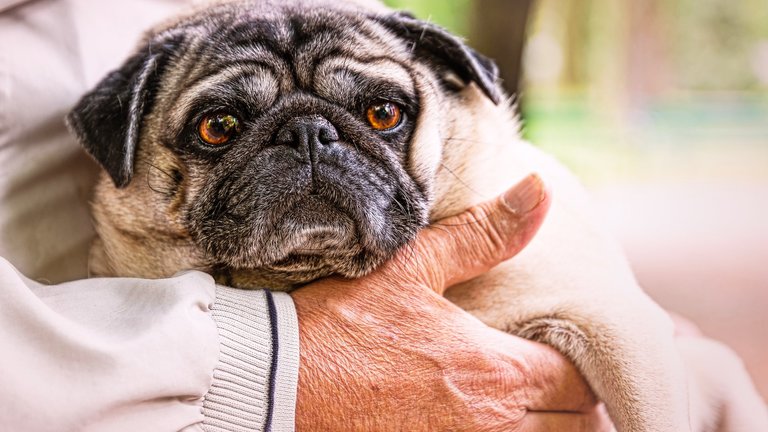How to manage dog arthritis symptoms in healthy weight and overweight dogs
Managing Dog Arthritis Symptoms in Healthy Weight and Overweight Dogs
1 in 5 dogs are arthritic, making osteoarthritis the single greatest cause of chronic pain in dogs. The heavier the dog, the more likely the onset of dog arthritis symptoms. The link between excess body weight and early onset of this disease well documented.
 Weight management eases dog arthritis symptoms.
Weight management eases dog arthritis symptoms.Therefore, the best preventive measure against dog osteoarthritis is to maintain your dog at a healthy body weight. And the most effective way to manage arthritis symptoms in overweight dogs is through weight management.
A University of Glasgow study * investigated the effects of weight loss in obese arthritic dogs. The study recorded significant improvement in lameness and pain after a commencing weight loss of just 6.1- 8.85 % body weight! Even more buoying was the fact that dogs in the study continued to improve in-line with ongoing weight loss.
Documented improvements such as these are especially encouraging for the pet parents of overweight and arthritic dogs.
Dog Arthritis Symptoms:
- stiffness,
- trouble rising from a resting position,
- difficulty with everyday activities such as climbing the stairs and getting into the car,
- reluctance to jump and run,
- limping,
- running with a skipping or hopping gait
- swollen and painful joints
- behavioral change e.g. reduced playfulness or aggression.
The development of any such symptoms should prompt a veterinary check-up.
 Is your dog slowing down or stiff when rising from rest? It's time for a vet check.
Is your dog slowing down or stiff when rising from rest? It's time for a vet check.4 Steps to Effectively Manage Dog Arthritis Symptoms:
1. Weight management:
Alleviate pressure on joints and improve mobility by maintaining your dog at their ideal weight. Help overweight dogs lose weight through a customised calorie and portion plan.
2. Provide regular low impact exercise:
Low intensity activities such as on-leash walking and swimming, do wonders for arthritic pets. Gentle exercise helps stimulate blood and nutrient flow to the joints, it improves flexibility and helps build muscle mass to stabilize joints. In fact, gentle exercise helps alleviate joint pain!
Many well-meaning owners believe it best not to exercise their arthritic dogs. This often results in increased stiffness and weight gain- exacerbating mobility issues! Keep your dog to a gentle activity program and seek advice from your veterinarian regarding effective pain management to help with your dog’s mobility.
3. Seek effective pain management to help ease arthritis symptoms:
Many dogs are stoic and do not overtly display signs of pain. Chronic pain is often interpreted by owners as their dog simply ageing or slowing down. Regular veterinary check-ups will determine whether your dog is arthritic or experiencing pain.
Most arthritic dogs benefit greatly from pain management. Quality of life improves dramatically as does mobility and the ability to exercise.
Pain management is achieved through anti-inflammatory medications, cartilage repair and protectant drugs (chondroprotectants) and nutritional supplements such as glucosamine and chondroitin.
Acupuncture and hydrotherapy also greatly benefit arthritic dogs.
 The well-being of arthritic dogs can improve dramatically with veterinary management.
The well-being of arthritic dogs can improve dramatically with veterinary management.4. Implement household measures to help your arthritic dog.
Provide your dog with a soft padded bed to cushion their joints. Avoid winter chills and keep your dog warm by bringing them indoors and using pet friendly heat pads or blankets.
Consider purpose-built ramps to aid your dog getting in and out of the car and raise the height of your dog’s food and water bowls.
 Avoid winter chills and provide soft cushioning to help alleviate dog arthritis symptoms.
Avoid winter chills and provide soft cushioning to help alleviate dog arthritis symptoms.Ultimately achieving a healthy weight for your dog is the best remedy and the best protection against arthritis! So, if your dog is a little on the cuddly side, start working towards your dog's healthy weight goal. Your dog will thank you!
*Marshall WG, Hazewinkel HAW, Mullen D, De Meyer G, Baert K, Carmichael S. The effect of weight loss on lameness in obese dogs with osteoarthritis. Veterinary Research Communications. 2010;34(3):241-253. doi:10.1007/s11259-010-9348-7.

